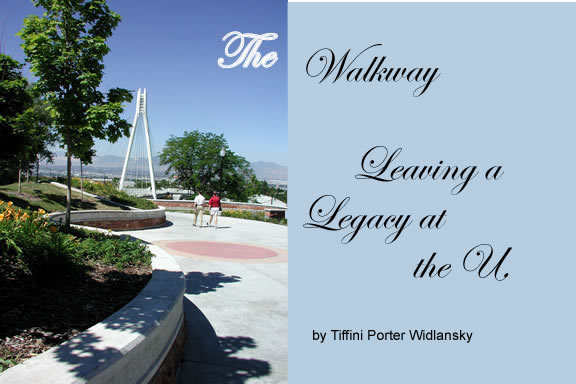
| Vol. 14 No. 2 | Fall 2004 |

Directly east of the George S. Eccles2002 Legacy Bridge and west of the Fort Douglas Officers Club winds a pedestrian path flanked by an ornamental wall made of red Utah sandstone. The wall, designed to exhibit a band of engraved copper plaques, each displaying names, logos, and tributes to and from University of Utah alumni, military personnel, community members—just about anyone—is replete with memories and pieces of history:
“Here’s to U for all you have meant to us: excellent professors, challenging classes, cultural events, personal growth, much fun, and lasting romance. Utes Forever!”
—Earl Wunderli [BA’56 JD’59] and Corrine Nelson Wunderli [BS’56]
With funding assis¬tance from the Katherine W. BS’51 and Ezekiel R. BA’50 Dumke Foundation, The Walkway was origi¬nally created to honor veterans and others associated with Fort Douglas. The con¬cept has expanded to embrace the larger University community and to symbolize the connection between the fort and lower campus. “It’s important to us to connect the new and the old and to make everyone in the area feel like they’re part of the U,” says Kay W. Lipman BS’62. She and her husband, Allan M. Lipman BS’56, were volunteer co-chairs for the Fort Douglas Heritage Commons Campaign. “The Walkway gives everyone the opportunity to honor someone or something special and to be part of the restoration of an American trea¬sure,” explains Allan.
The Walkway is an affordable way to make a mark on campus. “People are drawn to the simplicity, visibility, and permanence of the project,” says David Driggs BFA’86, director of major gifts at the U, “and there are some great stories on the wall.”
There are numerous military tales, including that of CDR Dale Harrison Osborne BS’56, known as “The Man Who Wouldn’t Die.” During his service as a Navy carrier pilot in Vietnam, Osborne was shot down, left for dead three times, and held as a POW, yet he survived and today lives in Utah. Another plaque rec¬ognizes members of the 10th Mountain Division: Rocco C. Siciliano BA’44, William S. Ryberg (KIA), Donald L. Fox BS’47, F. Ray Slight (KIA), Gordon A. Anderson BA’47, and E. Veldon Larson.All of these men fought together in Italy during World War II. Still another is dedi¬cated to Col. Ottis M. Plant, professor of military science and the man responsible for obtaining the “Thunder Ute” cannon, which is fired after Utah touchdowns at home football games.
Other plaques, like the one donated by Diana Devine Felt BS’44, give passersby a glimpse into the personal side of life at the U. Her simple tribute, “In memory of William L. Felt [BA’43] [who] married Diana Devine in the Post Chapel, May 1944,” hints at deep ties to Fort Douglas and the U.
The initial response to The Walkway has been positive, and there is talk of extending the wall across campus in the future. “The idea is that this will become a true campuswide tradition,” says Driggs. “People will be able to come back 20 years after graduating and say, ‘Here’s my name.’ It’s a great way to make a personal statement about one’s experience at the University.”
—Tiffini Porter Widlansky BS’96 is editorial assistant for Continuum.